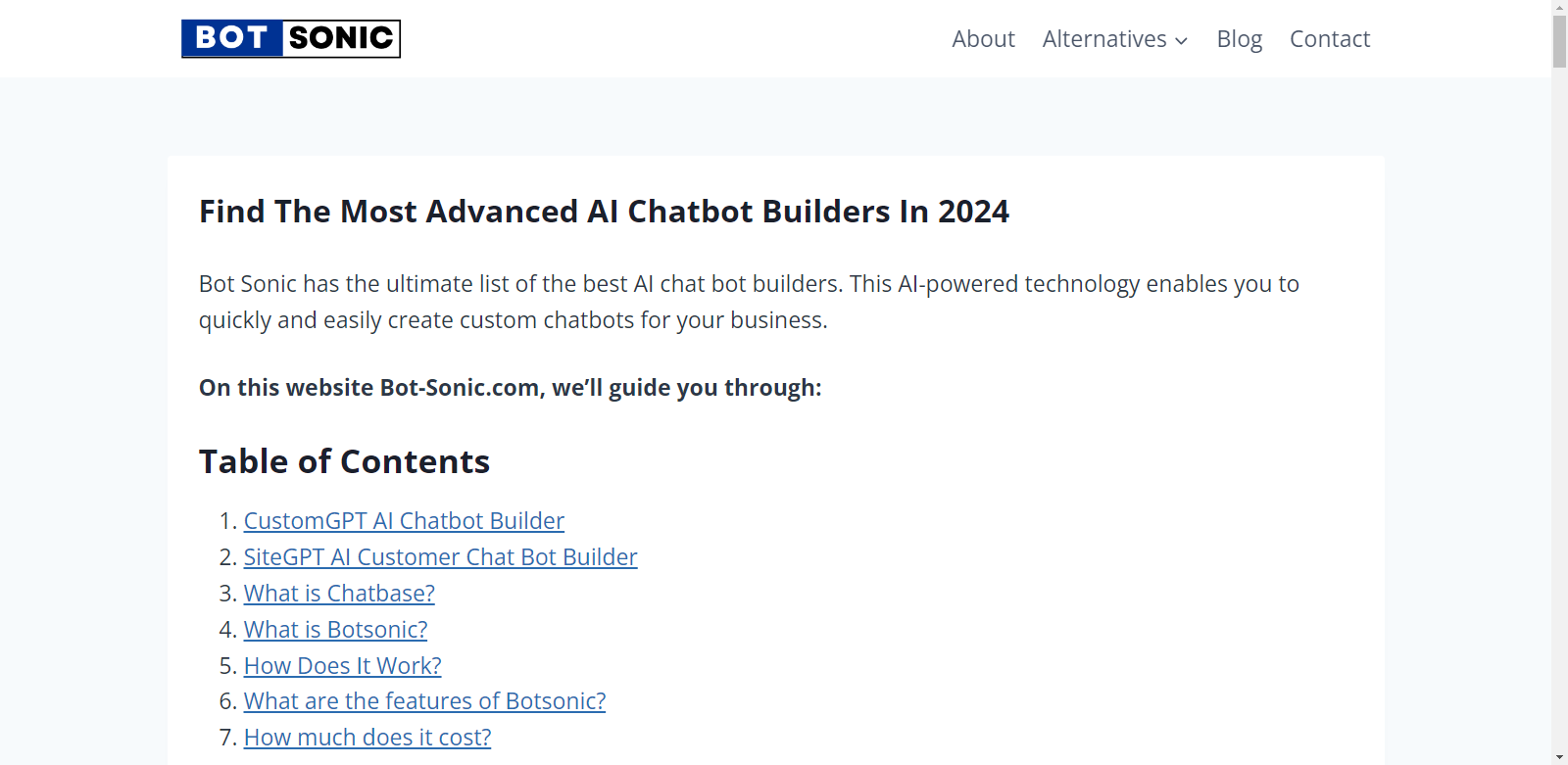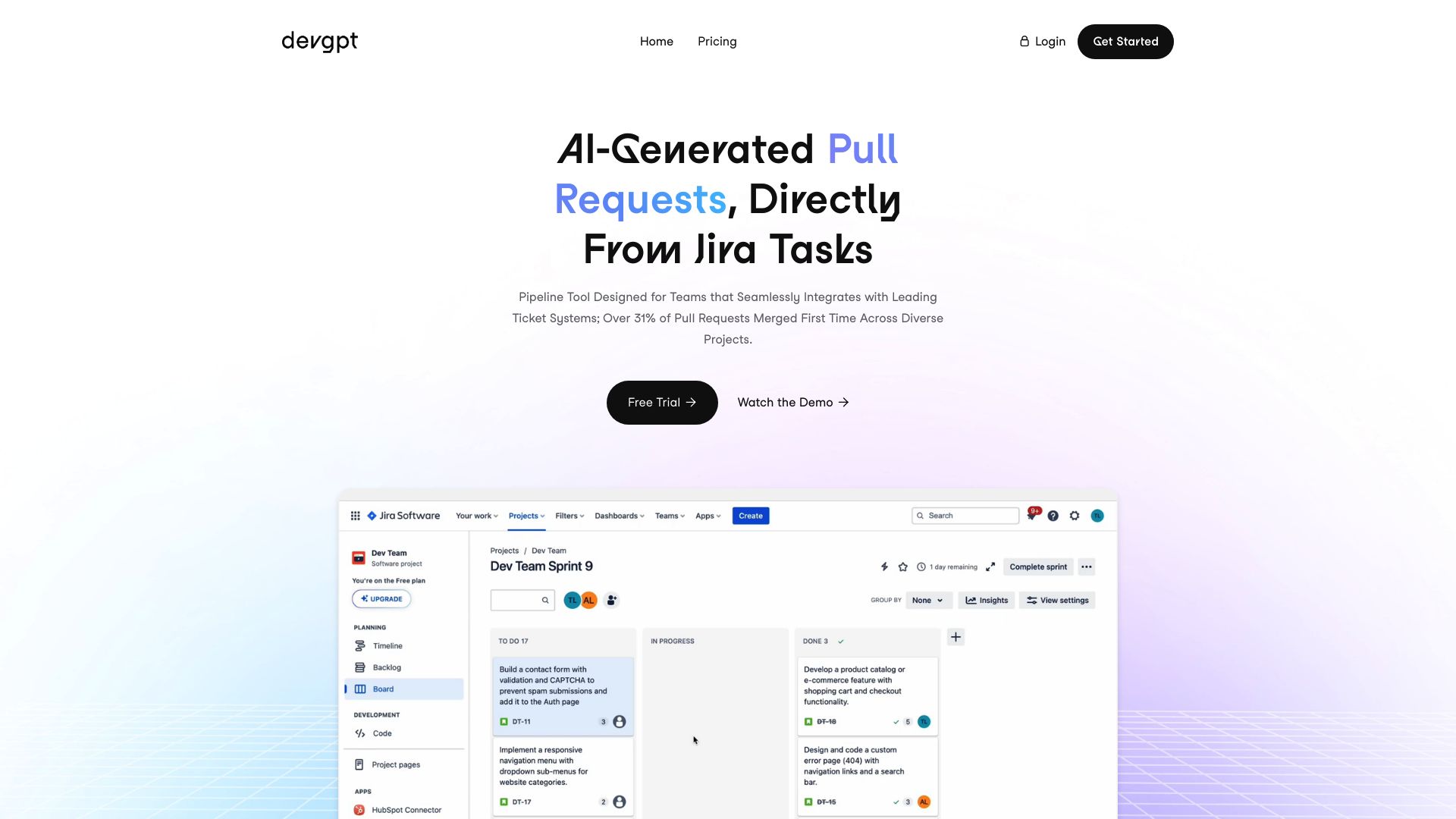Botsonic/Writesonic vs. DevGPT: Which AI Tool Fits Your Needs?
AI-powered development tools revolutionize how businesses create software and engage customers. This comparison examines Botsonic/Writesonic’s no-code chatbot platform, DevGPT’s code generation assistant, and SmythOS’s comprehensive AI development ecosystem. We evaluate each solution’s strengths, limitations, and target use cases to help technical teams, business leaders, and AI enthusiasts choose the right tool. From rapid chatbot deployment to streamlined coding and scalable AI agent creation, discover how these platforms address diverse development needs and which offers the most versatile, future-proof solution for your organization.
Botsonic/Writesonic Overview
Botsonic/Writesonic empowers businesses to create intelligent chatbots without coding expertise. This AI-powered platform leverages GPT-4 technology to deliver sophisticated conversational experiences across various industries.
Botsonic’s no-code visual builder enables rapid chatbot development and customization. Users can train their bots on diverse data sources including websites, documents, and YouTube videos. The platform supports multiple languages and integrates seamlessly with popular business tools like Salesforce and WhatsApp.
Botsonic’s no-code visual builder enables rapid chatbot development and customization. Users can train their bots on diverse data sources including websites, documents, and YouTube videos.


Key features include AI-powered intelligence for contextual conversations, extensive customization options to align with brand identity, and integration capabilities with various platforms. Botsonic aims to reduce support volume by up to 80%, allowing teams to focus on complex interactions.
While Botsonic offers robust functionality, it lacks some advanced features like debug mode for real-time troubleshooting, multimodal inputs, and multi-agent collaboration. The platform also doesn’t provide explicit constrained alignment to ensure strict adherence to predefined guidelines.
Botsonic positions itself as a versatile solution for businesses seeking to enhance customer engagement through AI-driven conversations. Its user-friendly interface and powerful AI capabilities make it accessible to both technical and non-technical users, though developers may find some advanced customization options limited compared to more code-centric platforms.
DevGPT Overview
DevGPT transforms the software development landscape by automating coding tasks through AI assistance. This open-source platform empowers developers to convert natural language descriptions into executable code, streamlining the development process and boosting productivity.


DevGPT’s core strength lies in its personalized training approach. The platform learns from a developer’s codebase, generating code that aligns with individual or team coding styles. This tailored output, coupled with editable suggestions, allows for fine-tuning and customization, ensuring the generated code meets specific project requirements.
DevGPT delivers high-quality code snippets that save developers significant time—with early users reporting over 10 hours saved per week.
Integration with popular development tools like GitHub and Jira enhances DevGPT’s utility. Developers can seamlessly generate pull requests from tasks or tickets, further accelerating the development workflow. By leveraging advanced models such as GPT-4 and Codex, DevGPT delivers high-quality code snippets that save developers significant time—with early users reporting over 10 hours saved per week.
While DevGPT excels in automating repetitive coding tasks, it currently focuses on serving individuals and small teams. This limitation may impact its scalability for larger enterprises or more complex development environments. Additionally, the platform’s reliance on existing codebases for training might pose challenges for teams starting new projects or working with unfamiliar technologies.
DevGPT’s vision extends beyond its current capabilities. The platform aims to become an indispensable AI-powered coding companion for developers and software teams of all sizes. By fostering an engaged community of users and contributors, DevGPT seeks to drive continuous improvement and expand its feature set, potentially addressing current limitations and enhancing its appeal to a broader range of developers and organizations.
Feature Comparison
Botsonic/Writesonic and DevGPT offer distinct approaches to AI-powered development, each with unique strengths and limitations. Botsonic/Writesonic excels in chatbot creation, providing a no-code visual builder that enables rapid deployment of conversational AI. Its integration with GPT-4 and support for multiple languages make it ideal for customer engagement across various industries. DevGPT, on the other hand, focuses on streamlining software development by generating code from natural language descriptions.
While both platforms aim to enhance productivity, they differ significantly in their core components and security features. Botsonic/Writesonic lacks advanced debugging tools and multi-agent collaboration capabilities, which could limit its utility for complex development scenarios. DevGPT’s personalized training approach allows it to generate code tailored to specific coding styles, but its current focus on individual developers and small teams may restrict its scalability for larger enterprises.
In terms of security, neither platform explicitly mentions constrained alignment features to ensure strict adherence to predefined guidelines. This gap could be a concern for organizations requiring robust governance over AI behavior. SmythOS addresses these limitations by offering a comprehensive suite of features including debug mode, multi-agent collaboration, and constrained alignment, positioning it as a more versatile solution for both conversational AI and code generation needs.
Feature Comparison Table
| Botsonic/Writesonic | DevGPT | SmythOS | |
|---|---|---|---|
| CORE FEATURES | |||
| Hosted Agents (Dev, Production) | ✅ | ❌ | ✅ |
| Environments (Dev, Production) | ✅ | ❌ | ✅ |
| Visual Builder | ❌ | ❌ | ✅ |
| No-Code Options | ✅ | ❌ | ✅ |
| Autonomous Agents | ✅ | ❌ | ✅ |
| Explainability & Transparency | ✅ | ❌ | ✅ |
| Debug Tools | ❌ | ✅ | ✅ |
| Multimodal | ❌ | ❌ | ✅ |
| Multi-Agent Collaboration | ❌ | ❌ | ✅ |
| Audit Logs for Analytics | ✅ | ❌ | ✅ |
| Work as Team | ❌ | ✅ | ✅ |
| Bulk Work | ❌ | ❌ | ✅ |
| Agent Work Scheduler | ❌ | ❌ | ✅ |
| Logs & Monitoring | ✅ | ❌ | ✅ |
| SECURITY | |||
| Constrained Alignment | ❌ | ❌ | ✅ |
| Data Encryption | ❌ | ❌ | ✅ |
| OAuth | ❌ | ❌ | ✅ |
| IP Control | ✅ | ❌ | ✅ |
| COMPONENTS | |||
| Foundation AIs | ✅ | ❌ | ✅ |
| Huggingface AIs | ❌ | ❌ | ✅ |
| Zapier APIs | ❌ | ❌ | ✅ |
| All other APIs, RPA | ✅ | ❌ | ✅ |
| Classifiers | ❌ | ❌ | ✅ |
| Logic | ✅ | ❌ | ✅ |
| Data Lakes | ❌ | ❌ | ✅ |
| DEPLOYMENT OPTIONS (EMBODIMENTS) | |||
| Deploy as API | ✅ | ❌ | ✅ |
| Deploy as Webhook | ❌ | ❌ | ✅ |
| Staging Domains | ❌ | ❌ | ✅ |
| Production Domains | ✅ | ❌ | ✅ |
| API Authentication (OAuth + Key) | ❌ | ❌ | ✅ |
| Deploy as Site Chat | ✅ | ❌ | ✅ |
| Deploy as Scheduled Agent | ❌ | ❌ | ✅ |
| Deploy as GPT | ✅ | ❌ | ✅ |
| Scalability | ✅ | ❌ | ✅ |
| DATA LAKE SUPPORT | |||
| Hosted Vector Database | ❌ | ❌ | ✅ |
| Sitemap Crawler | ✅ | ❌ | ✅ |
| YouTube Transcript Crawler | ✅ | ❌ | ✅ |
| URL Crawler | ✅ | ❌ | ✅ |
| PDF Support | ✅ | ❌ | ✅ |
| Word File Support | ✅ | ❌ | ✅ |
Best Alternative to Botsonic/Writesonic and DevGPT
SmythOS emerges as the superior alternative to Botsonic/Writesonic and DevGPT, offering a comprehensive platform for AI agent creation and deployment. We combine the strengths of both competitors while addressing their limitations, providing a versatile solution for businesses and developers alike.
Our visual builder surpasses the capabilities of Botsonic/Writesonic’s no-code options, allowing users to create complex AI workflows without extensive coding knowledge. Unlike DevGPT’s focus on individual developers, SmythOS scales effortlessly to meet enterprise-level demands, supporting multi-agent collaboration and advanced debugging tools.
SmythOS excels in security features, implementing constrained alignment and data encryption—critical aspects missing from both Botsonic/Writesonic and DevGPT.
SmythOS excels in security features, implementing constrained alignment and data encryption—critical aspects missing from both Botsonic/Writesonic and DevGPT. This ensures AI behavior aligns with organizational goals while protecting sensitive information.
We offer unparalleled flexibility in deployment options, enabling users to integrate AI agents seamlessly into existing systems. From APIs and webhooks to scheduled agents and GPT models, SmythOS adapts to diverse use cases across industries. Our platform’s extensive integration ecosystem, including support for various AI models and APIs, outperforms the limited options provided by competitors.
By choosing SmythOS, users gain access to a feature-rich platform that combines ease of use with advanced capabilities, positioning it as the ideal solution for those seeking to harness the full potential of AI agents in their workflows.
Conclusion
Botsonic/Writesonic and DevGPT offer valuable solutions for chatbot creation and code generation respectively, but SmythOS emerges as the superior choice for businesses seeking a comprehensive AI development platform. While Botsonic excels in no-code chatbot building and DevGPT streamlines coding tasks, both platforms have limitations in scalability and advanced features.
SmythOS addresses these shortcomings by providing a versatile ecosystem that supports multi-agent collaboration, debug mode, and constrained alignment. Its drag-and-drop interface, coupled with extensive API integrations and support for various AI models, makes it accessible to both technical and non-technical users. This flexibility allows SmythOS to cater to a wider range of industries and use cases, from customer support chatbots to complex software development workflows.
The platform’s ability to deploy AI agents across multiple environments and its robust security features set it apart from competitors. With SmythOS, businesses can create once and deploy anywhere, whether it’s as an API, a website chatbot, or a scheduled agent. This versatility, combined with features like data lake support and multimodal capabilities, positions SmythOS as a future-proof solution for enterprises looking to harness the full potential of AI.
For those ready to revolutionize their AI development process, explore SmythOS’s diverse range of AI-powered agent templates to jumpstart your projects. Experience the power of seamless AI integration by creating a free SmythOS account and start building intelligent agents today. With its comprehensive features and user-friendly interface, SmythOS is poised to lead the next wave of AI innovation across industries.
Last updated:
Disclaimer: The information presented in this article is for general informational purposes only and is provided as is. While we strive to keep the content up-to-date and accurate, we make no representations or warranties of any kind, express or implied, about the completeness, accuracy, reliability, suitability, or availability of the information contained in this article.
Any reliance you place on such information is strictly at your own risk. We reserve the right to make additions, deletions, or modifications to the contents of this article at any time without prior notice.
In no event will we be liable for any loss or damage including without limitation, indirect or consequential loss or damage, or any loss or damage whatsoever arising from loss of data, profits, or any other loss not specified herein arising out of, or in connection with, the use of this article.
Despite our best efforts, this article may contain oversights, errors, or omissions. If you notice any inaccuracies or have concerns about the content, please report them through our content feedback form. Your input helps us maintain the quality and reliability of our information.
